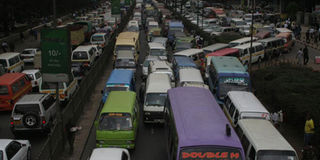Time to transform the dashboard technology

The many gadgets and instruments fitted to cars have generally improved in line with overall advances in technology, materials and design. PHOTO | FILE
What you need to know:
- As long ago as the 1960s, a simple gadget called a “vacuum gauge” was a common fitting and a universally available accessory.
- Its dial had green, yellow and red bands, and a needle that told you at-a-glance whether your engine’s fuel demand (in response to your driving) was economical, average or greedy.Vacuum gauges have not been widely replaced by something even better.
The many gadgets and instruments fitted to cars have generally improved in line with overall advances in technology, materials and design. There are two-and-a-half exceptions to this trend. After more than a century of development of the rest of the car, most fuel gauges remain unimproved and damnably vague. The sensors in your fuel tank (usually a primitive float) must be heavily suppressed so there is no chance of an electrical spark, but there is no technical reason why today’s advanced digital telemetry cannot give you an exact dashboard reading of how many litres of fuel you have consumed and how many litres remain in the tank … to the nearest decimal point! They could and should be so accurate that you can even tell whether the calibration of a fuel station pump has been tampered with. Some modern cars do now have precise digital read-outs, but the majority still give you a needle that is so non-specific, inaccurate and erratic that the only viable marks on the dial are full, or half, or empty – and all three of those tell lies.
What your fuel telemetry could also do is tell you how much you are consuming at any given instant during a journey. A fuel-flow meter of some sort. A vehicle that averages, say, 10 km per litre doesn’t consume fuel at that rate all the time, nor even slightly more and slightly less depending on how hard it is being driven. The actual fuel consumption on such a car, on a normal journey, could range from 1 km per litre to 100 km per litre from one second to the next, and driving style can profoundly affect the proportions and durations of those good and bad moments. Fuel flow readings are a considerable aid to economical driving techniques.
But while fuel consumption has become a global priority, with massive investment in fuel-saving design and technology (alongside an unprecedented ability to measure with exactitude) car instruments have not only failed to keep up; they have taken a backward step. As long ago as the 1960s, a simple gadget called a “vacuum gauge” was a common fitting and a universally available accessory. Its dial had green, yellow and red bands, and a needle that told you at-a-glance whether your engine’s fuel demand (in response to your driving) was economical, average or greedy. Vacuum gauges have not been widely replaced by something even better. They’ve simply disappeared.Another “half” backward step has come in parallel with a really good advance – the invention of hazard warning flashers, making good use of your existing direction indicator lights and adding a really useful warning signal to the motoring menu. Their warning message is most crucial in an emergency, so it should be possible to trigger them without time, without thought, in the dark, even by a person whose visual or physical capacity might have been severely compromised. That means every hazard warning flasher button on every vehicle should be in the same place (probably on top of the steering column) and operate in the same user-friendly/user-disabled way. It’s high time international motor manufacturing design standards said so.





